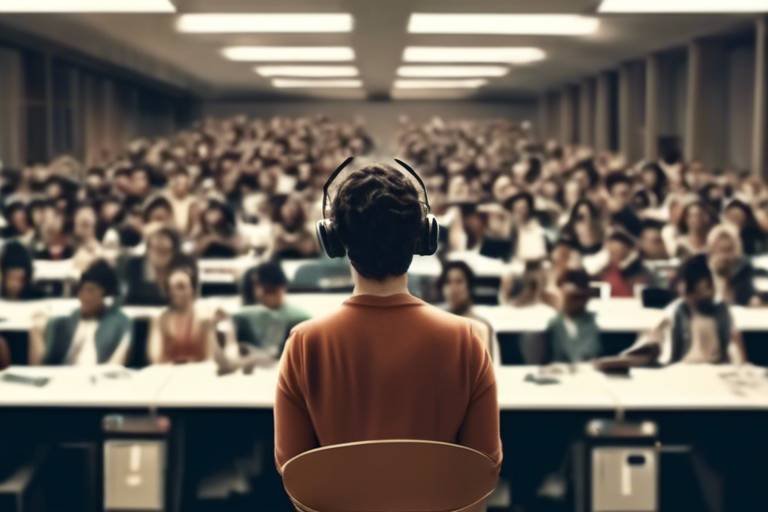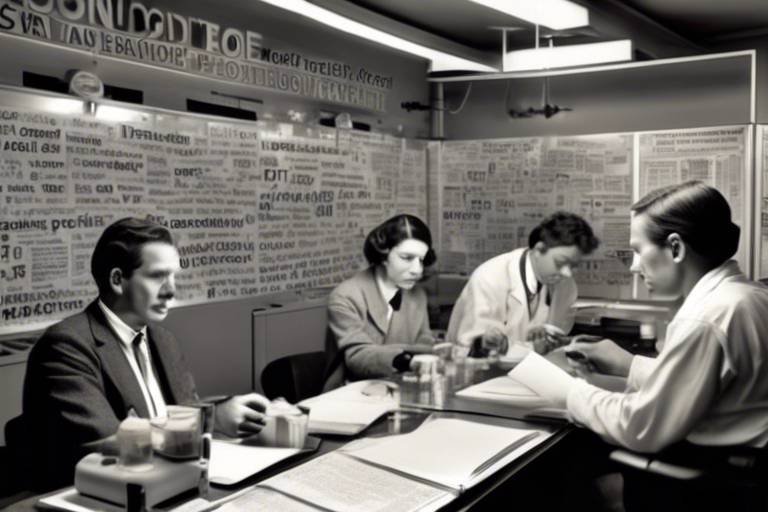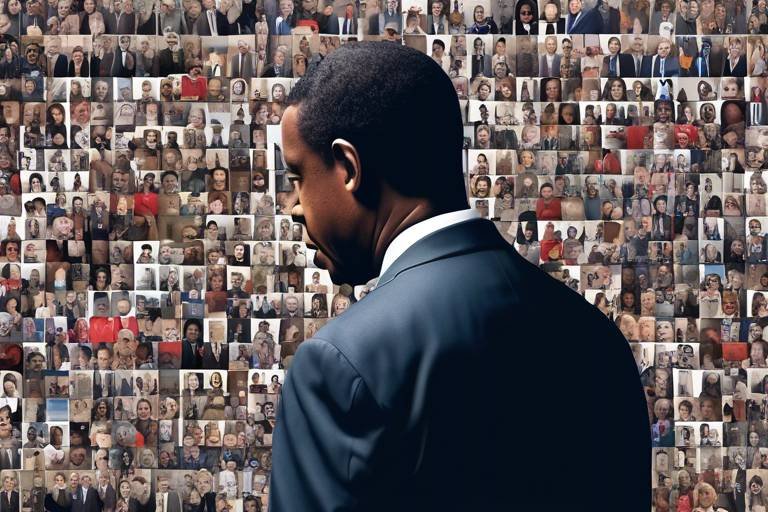How Tech is Influencing Global Communication Styles
In today's fast-paced world, technology is not just a tool; it’s a transformative force that shapes how we connect with one another. Gone are the days when a letter took weeks to reach its destination or when long-distance phone calls were a luxury. Now, with just a few taps on our smartphones, we can communicate with anyone across the globe in real-time. This seismic shift in communication styles has not only made the world feel smaller but has also paved the way for a more interconnected global community.
Consider this: how often do you find yourself chatting with friends or colleagues from different countries? Thanks to instant messaging apps, social media platforms, and video conferencing tools, we are able to share ideas, cultures, and experiences like never before. Each of these technologies plays a pivotal role in breaking down barriers and fostering a sense of global citizenship. But what does this mean for our traditional communication methods? Are we losing the essence of face-to-face interactions, or are we simply evolving into a new form of communication?
The impact of technology on global communication styles is profound. For instance, think about how emojis and GIFs have become a universal language that transcends words. They add a layer of expression that often gets lost in text. Furthermore, technology has introduced us to new communication norms and expectations. People now expect immediate responses, which can lead to a culture of instant gratification. Yet, this can also create stress and anxiety, as individuals feel pressured to be constantly available and responsive.
Moreover, technology has democratized communication. Anyone with internet access can share their thoughts and ideas with a global audience. This shift has given rise to citizen journalism, where ordinary people report news and events, often with a unique perspective that mainstream media might overlook. However, this democratization also comes with challenges, such as the spread of misinformation and the need for critical thinking skills to navigate the vast sea of information available online.
As we delve deeper into this topic, it's essential to recognize that while technology has enhanced our ability to communicate, it has also introduced complexities that we must navigate. The balance between embracing these advancements and maintaining meaningful connections is crucial. So, how do we adapt to this new landscape while ensuring that our communication remains authentic and impactful?
- How has technology changed the way we communicate? Technology has made communication faster, more accessible, and more diverse, allowing for real-time interactions across the globe.
- Are there downsides to digital communication? Yes, challenges include misinterpretation of messages, lack of non-verbal cues, and the potential for cyberbullying.
- What role does social media play in global communication? Social media platforms facilitate instant sharing of ideas and cultural exchanges, influencing public discourse and trends.
- How can we maintain personal connections in a digital world? Using video calls and instant messaging can help maintain emotional connections despite physical distances.

The Rise of Instant Messaging
Instant messaging applications have truly transformed the way we communicate in today's fast-paced world. Gone are the days when sending a message meant waiting days for a reply; now, we can have real-time conversations that transcend geographical barriers and cultural differences. Imagine being able to chat with a friend in Tokyo while sipping coffee in New York—this is the power of instant messaging!
These platforms have not only made communication faster but also more accessible. With just a few taps on our smartphones, we can connect with anyone, anywhere, at any time. This has fostered a more interconnected global community, where ideas and experiences can be shared instantly. But what does this mean for our communication styles? For starters, it encourages brevity. We’ve all seen how a simple emoji can convey a whole range of emotions without a single word. This shift towards concise messaging is reshaping how we express ourselves.
Furthermore, instant messaging has become a vital tool for both personal and professional interactions. In the workplace, teams can collaborate more efficiently through platforms like Slack or Microsoft Teams. Here’s a quick look at how instant messaging is influencing various aspects of our lives:
| Aspect | Impact of Instant Messaging |
|---|---|
| Personal Communication | Facilitates quick and casual conversations, enhancing relationships. |
| Professional Collaboration | Enables real-time project updates and brainstorming sessions. |
| Cultural Exchange | Encourages sharing of diverse perspectives and experiences. |
However, while instant messaging has its advantages, it also comes with its own set of challenges. For instance, the lack of non-verbal cues can lead to misunderstandings. How many times have you misinterpreted a text simply because you couldn't see the sender's facial expression? It’s a common pitfall in the digital communication landscape.
In conclusion, instant messaging has undeniably revolutionized how we communicate. It has made the world feel smaller, allowing us to connect with others in ways we never thought possible. As we continue to adapt to these changes, it’s essential to navigate the balance between the speed of communication and the clarity of our messages. So, the next time you send a quick "LOL" or a thumbs-up emoji, remember the vast world of communication that lies behind that simple gesture!

The Impact of Social Media
Social media has become a pivotal force in shaping how we communicate, interact, and perceive the world around us. It’s fascinating to think about how platforms like Facebook, Twitter, Instagram, and TikTok have transformed our daily conversations into a global dialogue. No longer are we confined to our local communities; instead, we are part of a vast, interconnected web of information and interaction. This shift has not only changed the way we communicate but also the very fabric of our social interactions.
One of the most significant impacts of social media is its ability to facilitate instant communication. Imagine being able to connect with someone across the globe in mere seconds! This immediacy has fostered a culture of quick exchanges and real-time updates, allowing us to share our thoughts and experiences as they happen. This has led to a more engaged and informed public, but it also raises questions about the quality of discourse. Are we sacrificing depth for speed?
Moreover, social media platforms serve as a stage for public discourse, where ideas can be shared, debated, and disseminated rapidly. This has democratized communication, giving a voice to the voiceless and enabling grassroots movements to gain traction. For instance, the #MeToo movement and various climate change initiatives have gained momentum through social media, showcasing its power to mobilize communities and spark global conversations.
However, with great power comes great responsibility. The rapid spread of information can lead to misinformation and polarized opinions. It’s crucial for users to critically evaluate the content they encounter. To help navigate this complex landscape, here are some key points to consider:
- Verify Sources: Always check the credibility of the information before sharing.
- Engage Respectfully: Foster constructive conversations rather than fueling negativity.
- Be Aware of Echo Chambers: Challenge your own beliefs by seeking diverse perspectives.
Additionally, social media has significantly influenced cultural trends and language use. New slang and abbreviations have emerged, reflecting the unique communication styles of different online communities. Emojis and GIFs have become the modern hieroglyphics, allowing users to express emotions and reactions in a way that transcends language barriers. This evolution of language is a testament to the adaptability of human communication, as we continuously find new ways to express ourselves in the digital age.
In summary, the impact of social media on communication is profound and multifaceted. It has reshaped how we connect with others, influenced public discourse, and even transformed language itself. As we navigate this ever-evolving landscape, it’s essential to remain mindful of both the opportunities and challenges that come with it. The future of communication is bright, but it requires us to engage thoughtfully and responsibly.
- How has social media changed communication? Social media has made communication faster, more accessible, and has allowed for global interactions, reshaping cultural exchanges.
- What are some challenges of social media communication? Challenges include misinformation, the spread of negativity, and the potential for misinterpretation due to the lack of non-verbal cues.
- Can social media influence public opinion? Yes, social media platforms can significantly impact public discourse and influence societal trends and movements.

Global Networking Opportunities
The digital age has ushered in an era where the concept of networking has transcended traditional boundaries. Gone are the days when connecting with someone in another country required a letter or an expensive phone call. Now, with just a few clicks, you can engage with professionals, creatives, and thought leaders from all corners of the globe. This transformation is not just about convenience; it’s about opportunity. Imagine being able to collaborate on projects with people from diverse backgrounds, each bringing unique insights and skills to the table. This is the magic of global networking!
Social media platforms like LinkedIn, Twitter, and even niche forums have become vital tools for building these connections. Users can share their expertise, showcase their work, and even seek advice or mentorship from industry leaders. The ability to engage in real-time discussions and share ideas instantly has made networking more dynamic than ever. Think of it as a global marketplace of ideas where everyone can contribute, learn, and grow. Here are a few key benefits of global networking:
- Access to Diverse Perspectives: Engaging with individuals from different cultural backgrounds can spark innovation and creativity.
- Career Advancement: Networking globally opens doors to job opportunities that you might not find in your local market.
- Collaborative Projects: Many businesses are now seeking international partnerships, allowing for richer project outcomes.
Moreover, global networking has become particularly crucial in times of crisis. For instance, during the pandemic, professionals turned to online platforms to maintain connections and share resources. This adaptability not only kept businesses afloat but also fostered a sense of community and support among peers worldwide. The ability to share knowledge and experiences across borders has created a rich tapestry of collaboration that enhances the global workforce.
As we move forward, it's evident that the future of networking will be shaped by technology. Innovations such as virtual reality meetings and augmented reality interactions are on the horizon, promising to make connections even more immersive. Imagine attending a virtual conference where you can interact with participants as if you were all in the same room! The possibilities are endless, and the potential for growth and collaboration is immense.
In conclusion, global networking opportunities have redefined how we connect, collaborate, and innovate. The digital landscape has made it easier than ever to reach out, share ideas, and build lasting relationships that can propel both personal and professional growth. So, whether you’re an entrepreneur, a job seeker, or just someone looking to expand your horizons, embracing these global networking opportunities could be your ticket to a world of possibilities!
Q: How can I start networking globally?
A: Begin by joining online platforms like LinkedIn, participating in webinars, and engaging in discussions on social media. Don't hesitate to reach out to people whose work you admire!
Q: What are some effective strategies for global networking?
A: Be authentic, share valuable content, and follow up with connections you make. Building genuine relationships takes time, so be patient and consistent.
Q: Are there any risks associated with global networking?
A: Yes, as with any online interaction, there can be risks such as miscommunication or encountering unprofessional behavior. Always use discretion and maintain a professional demeanor.

Cross-Cultural Collaborations
In today's globalized world, have become not just a trend but a necessity. Thanks to digital platforms, teams from different corners of the globe can come together to share their unique insights and skills. Imagine a tech startup in San Francisco teaming up with a design firm in Tokyo—this is the new normal! The beauty of these collaborations lies in the diversity they bring. Each culture has its own way of thinking, problem-solving, and creating, which can lead to innovative solutions that would be impossible within a single cultural framework.
Moreover, the rise of collaborative tools such as Slack, Trello, and Zoom has made it easier than ever to work together, regardless of time zones and geographical distances. These tools not only facilitate communication but also help in project management, ensuring everyone is on the same page. For instance, while one team is waking up in New York, another is wrapping up their day in Mumbai, and they can easily exchange ideas in real-time. This level of interaction fosters a sense of unity and shared purpose, which is essential for any successful project.
However, it's important to recognize that cross-cultural collaborations come with their own set of challenges. Differences in communication styles, work ethics, and even attitudes towards deadlines can lead to misunderstandings. For example, while some cultures may value directness in communication, others might prefer a more nuanced approach. To navigate these waters successfully, teams must be willing to embrace cultural differences and adapt their communication strategies accordingly. This adaptability not only enhances collaboration but also enriches the overall experience for everyone involved.
One effective way to bridge cultural gaps is through cultural sensitivity training. This training can help team members understand and appreciate each other's backgrounds, leading to more effective interactions. Additionally, creating a shared team culture that respects and celebrates diversity can go a long way in fostering collaboration. When team members feel valued and understood, they are more likely to contribute their best ideas and efforts.
In conclusion, cross-cultural collaborations are a powerful way to harness global talent and innovation. By leveraging technology and maintaining an open mind, teams can create solutions that are not only effective but also culturally rich. As we continue to embrace this interconnected world, the potential for creativity and collaboration knows no bounds.

Influence on Language Use
In today's fast-paced digital world, the way we communicate has undergone a significant transformation, particularly in how language is used. With the rise of social media platforms like Twitter, Instagram, and TikTok, we are witnessing an explosion of new slang, abbreviations, and even entirely new languages that are reshaping our communication landscape. It's fascinating to think about how a simple tweet or a meme can create a ripple effect, influencing not just how we talk but also how we think and express ourselves.
One of the most notable changes is the use of **abbreviations** and **acronyms**. Terms like "LOL" (laugh out loud), "BRB" (be right back), and "FOMO" (fear of missing out) have become part of our everyday vocabulary. These shorthand expressions allow us to convey emotions and reactions quickly, making communication more efficient but also less formal. It's almost like we are creating a new dialect, one that is uniquely suited for the digital age.
Moreover, the influence of technology on language isn't just about speed; it's also about creativity. Users often play with words, creating puns and portmanteaus that reflect current trends or cultural phenomena. For example, the term "hangry," which combines "hungry" and "angry," perfectly captures that all-too-common feeling of irritability that arises when one is hungry. This playful manipulation of language not only makes communication more engaging but also fosters a sense of community among users who share in these linguistic innovations.
Additionally, the global nature of the internet means that languages are constantly interacting and evolving. English, which has become the lingua franca of the digital world, is absorbing words and phrases from other languages at an unprecedented rate. This cross-pollination enriches our vocabulary and reflects the diverse cultures that make up our global community. For instance, words like "schadenfreude" (German for pleasure derived from another's misfortune) and "déjà vu" (French for already seen) have found their way into everyday English usage, showcasing how technology facilitates cultural exchange.
However, this evolution of language also raises some concerns. As we embrace new forms of communication, there is a risk of losing the richness and depth of traditional language. The reliance on emojis and GIFs to express feelings can sometimes lead to misunderstandings, as the nuances of human emotion are often lost in translation. Furthermore, the rapid pace of change can make it challenging for older generations to keep up, creating a linguistic divide that can hinder effective communication.
In summary, the influence of technology on language use is profound and multifaceted. It has opened up new avenues for expression and creativity while also presenting challenges that we must navigate. As we continue to communicate in this digital age, it's essential to embrace these changes while also appreciating the beauty and complexity of language in all its forms.
- How has social media changed the way we communicate? Social media has introduced new slang, abbreviations, and informal language, making communication faster and often more creative.
- Are there any downsides to the evolution of language due to technology? Yes, reliance on digital communication can lead to misunderstandings and a loss of traditional language depth.
- What role does English play in global communication? English has become the dominant language of the internet, facilitating communication across diverse cultures and languages.

Challenges of Digital Communication
While the advances in digital communication have brought about a wealth of opportunities, they also come with a set of challenges that can complicate our interactions. One of the most significant issues is misinterpretation. Without the nuances of face-to-face conversation—such as tone of voice, facial expressions, and body language—messages can easily be misunderstood. For example, a simple text message can be read in multiple ways, leading to confusion and unnecessary conflict. This lack of clarity can create barriers in both personal and professional relationships.
Moreover, the absence of non-verbal cues can lead to what many refer to as the “digital disconnect.” When we communicate through screens, we miss out on the subtle signals that convey emotions and intentions. Have you ever sent a message that was intended to be light-hearted, only for the recipient to take it the wrong way? This phenomenon is common in digital communication and can escalate tensions unnecessarily.
Another challenge that has emerged in the digital age is the potential for cyberbullying. The anonymity provided by the internet can embolden individuals to say things they would never say in person, leading to harmful interactions that can have lasting effects on mental health. This issue is particularly prevalent among younger users of social media, where the pressure to fit in can lead to negative behaviors and outcomes.
Additionally, the overwhelming amount of information available online can lead to information overload. With countless messages, notifications, and updates vying for our attention, it can be difficult to focus on what truly matters. This bombardment of information can lead to stress and anxiety, making it harder for individuals to engage meaningfully with others.
To summarize, while digital communication has its perks, it is essential to remain aware of these challenges. Here’s a quick overview:
- Misinterpretation: Messages can easily be misunderstood without non-verbal cues.
- Digital Disconnect: Lack of face-to-face interaction can lead to emotional detachment.
- Cyberbullying: Anonymity can encourage harmful behaviors online.
- Information Overload: The sheer volume of communication can lead to stress and distraction.
As we navigate the complexities of digital communication, it’s crucial to develop strategies to mitigate these challenges. Being mindful of our language, taking the time to clarify our messages, and fostering a supportive online environment can help us communicate more effectively in this ever-evolving digital landscape.
Q1: What are some common issues in digital communication?
A1: Common issues include misinterpretation of messages, lack of non-verbal cues, cyberbullying, and information overload.
Q2: How can I improve my digital communication skills?
A2: To improve, be clear and concise in your messages, use emojis to convey tone, and take the time to understand the context of conversations.
Q3: What should I do if I experience cyberbullying?
A3: It's important to report the behavior to the platform, seek support from friends or family, and consider professional help if needed.

The Role of Video Conferencing
Video conferencing technology has dramatically transformed the way we communicate, especially in a world where physical distance can often be a barrier. Imagine being able to sit in your living room while having a face-to-face conversation with a colleague halfway across the globe. This is not just a fantasy; it’s the reality of modern communication. Video conferencing platforms like Zoom, Microsoft Teams, and Google Meet have made it easier than ever to connect with others, bridging the gap between personal and professional interactions.
One of the most significant advantages of video conferencing is its ability to enhance understanding and connection. Unlike traditional phone calls or emails, video calls allow participants to see each other's facial expressions and body language. This visual component adds a layer of context that can often be missing in other forms of communication. For instance, during a video meeting, you might notice a colleague's nod of agreement or a furrowed brow of confusion, cues that can guide the conversation in real time. This is especially crucial in professional settings, where clarity and collaboration are key to success.
Moreover, video conferencing tools have become essential for team collaboration. They enable real-time discussions, brainstorming sessions, and decision-making processes that are vital for project success. Teams can share screens, present documents, and even collaborate on projects simultaneously, creating an interactive environment that fosters creativity and productivity. For example, imagine a marketing team working on a campaign strategy. With video conferencing, they can all contribute ideas and feedback instantly, regardless of their physical locations. This not only saves time but also enhances the quality of the work produced.
However, it’s not just professional relationships that benefit from video conferencing; personal connections thrive as well. In our fast-paced lives, maintaining relationships can be a challenge. Video calls allow friends and family to stay connected despite the miles that separate them. Whether it’s a virtual family gathering or a casual catch-up with a friend, seeing each other’s faces can make conversations more meaningful. It’s like having a mini-reunion, where laughter and shared moments can be experienced in real-time, making the distance feel less daunting.
In summary, video conferencing has become an integral part of our communication landscape. It enhances collaboration, fosters personal connections, and breaks down geographical barriers. As we continue to embrace this technology, it’s clear that video conferencing will play a pivotal role in shaping how we interact, both personally and professionally.
- What is video conferencing? Video conferencing is a technology that allows users in different locations to hold face-to-face meetings using video and audio transmissions over the internet.
- What are the benefits of video conferencing? Benefits include enhanced communication, reduced travel costs, increased productivity, and the ability to connect with anyone, anywhere.
- Can video conferencing be used for personal connections? Absolutely! Video conferencing is great for keeping in touch with friends and family, especially when distance is a factor.
- What platforms are commonly used for video conferencing? Popular platforms include Zoom, Microsoft Teams, Google Meet, and Skype, each offering unique features for users.

Enhancing Team Collaboration
In today's fast-paced world, effective team collaboration is more crucial than ever. With the advent of video conferencing technologies, teams can communicate in real-time, regardless of their physical locations. Imagine being able to brainstorm ideas with colleagues from different continents as if they were sitting right next to you! This is the power of video conferencing, and it has completely transformed the way we work together.
Video conferencing tools like Zoom, Microsoft Teams, and Google Meet have become household names, allowing teams to hold meetings, share screens, and even collaborate on documents simultaneously. This seamless integration of technology into our work processes has led to a significant increase in productivity and creativity within teams. For instance, a team spread across various time zones can schedule a virtual meeting that accommodates everyone, ensuring that all voices are heard and valued.
Moreover, video conferencing fosters a sense of belonging and inclusivity among team members. When people see each other's faces, it creates a more personal connection that can often be missing in traditional email or chat communications. This visual interaction helps to build trust and rapport, which are essential for effective teamwork. It’s like the difference between sending a postcard and sharing a cup of coffee with a friend; the latter creates a deeper bond.
Additionally, these platforms often come equipped with features that enhance collaboration, such as:
- Screen sharing: This allows team members to present their ideas visually, making discussions more engaging.
- Breakout rooms: These enable smaller groups to discuss specific topics before regrouping, ensuring that everyone has a chance to contribute.
- Recording options: Teams can record meetings for future reference, which is particularly useful for those who cannot attend live.
In essence, video conferencing not only enhances communication but also revolutionizes the way teams collaborate. By bridging the gap between remote workers, it ensures that everyone is on the same page, working towards common goals. As we continue to adapt to a more digital world, embracing these tools is no longer optional; it’s essential for success.
Q: How do video conferencing tools improve team collaboration?
A: Video conferencing tools improve team collaboration by enabling real-time communication, fostering personal connections, and providing features that enhance group discussions, such as screen sharing and breakout rooms.
Q: Can video conferencing replace in-person meetings?
A: While video conferencing can replicate many aspects of in-person meetings, it may not fully replace the value of face-to-face interactions. However, it is a highly effective alternative, especially for remote teams.
Q: What are some popular video conferencing platforms?
A: Popular video conferencing platforms include Zoom, Microsoft Teams, Google Meet, and Cisco Webex, each offering unique features to facilitate communication and collaboration.
Q: Is it possible to record video conferences?
A: Yes, most video conferencing tools offer a recording feature that allows users to capture meetings for future reference, which can be beneficial for those who are unable to attend.

Building Personal Connections
In today's fast-paced digital world, maintaining personal connections can often feel like a daunting task. However, thanks to the rise of video conferencing technology, we now have the tools to bridge the gap created by distance. Imagine being able to see your loved ones or colleagues face-to-face, no matter where they are in the world. This is not just a luxury; it's a necessity in our increasingly global society. With platforms like Zoom, Skype, and Google Meet, personal interactions have become more accessible and engaging than ever before.
Video calls allow us to share experiences in real-time, making conversations feel more genuine and heartfelt. When we can see the expressions on someone's face or the excitement in their eyes, it creates a connection that a simple text message or email simply cannot replicate. It's akin to being in the same room, sharing a cup of coffee, and catching up on life. This visual element is crucial, as it enhances our understanding of each other and fosters empathy, which is often lost in text-based communication.
Moreover, these virtual meetings can be tailored to fit our needs. Whether it's a casual catch-up with friends or a more structured meeting with colleagues, the flexibility of video conferencing means we can connect on our own terms. You can even create a cozy atmosphere by setting up a comfortable space at home, adding personal touches like your favorite mug or a background that reflects your personality. This adds an extra layer of intimacy to the interaction, making it feel more personal and less transactional.
However, it's essential to remember that building personal connections through video conferencing requires effort and intention. Here are some tips to enhance your virtual interactions:
- Be Present: Just like in face-to-face meetings, it's important to minimize distractions. Close unnecessary tabs, put your phone away, and give your full attention to the conversation.
- Engage Actively: Ask questions, share stories, and encourage others to do the same. This creates a two-way dialogue that strengthens relationships.
- Follow Up: After your call, send a quick message or email to express your appreciation for the conversation. This simple gesture can leave a lasting impression.
In conclusion, video conferencing has revolutionized how we build and maintain personal connections. By leveraging this technology, we can create meaningful interactions that transcend geographical boundaries. As we continue to navigate this digital landscape, let's embrace the opportunities it presents to strengthen our relationships, both personal and professional. The future of communication is indeed bright, and it’s up to us to make the most of it.
Q: How can I improve my video conferencing skills?
A: Practice makes perfect! Familiarize yourself with the platform, ensure good lighting, and engage actively with participants.
Q: What are some common mistakes to avoid during video calls?
A: Avoid multitasking, ensure your background is appropriate, and remember to mute yourself when not speaking to minimize distractions.
Q: Can video conferencing replace in-person meetings?
A: While video conferencing offers many advantages, it may not fully replace the nuances of in-person interactions. However, it serves as an excellent alternative when physical meetings are not possible.

Future Trends in Communication Technology
The world of communication technology is on the brink of a revolution, with exciting advancements that promise to reshape how we connect and interact. As we look to the future, it's clear that augmented reality (AR), artificial intelligence (AI), and virtual reality (VR) are not just buzzwords; they are set to become integral parts of our daily communication experiences. Imagine a world where you can have a meeting in a virtual boardroom, no matter where you are, or where your colleagues are scattered across the globe. This is not science fiction; it's the direction we are heading towards!
One of the most intriguing trends is the rise of augmented reality. Picture this: you’re in a café, and instead of just texting your friend, you can send them a live video feed of your surroundings, overlaid with digital information about the place. AR has the potential to create immersive experiences that blend the digital and physical worlds, making communication not just about words but about shared experiences. This could revolutionize how we share our lives, making every interaction richer and more engaging.
On the other hand, artificial intelligence is already making waves in communication technology. AI-driven chatbots are becoming increasingly sophisticated, capable of understanding and responding to human emotions and queries in real-time. These bots can handle customer service inquiries, schedule meetings, and even provide personalized recommendations based on user preferences. As AI continues to evolve, we can expect even more seamless and intuitive interactions, making communication smoother than ever before.
Moreover, virtual reality is set to change the game for remote communication. Imagine attending a conference where you feel as if you are physically present, interacting with others in a virtual space. VR can create environments that simulate real-life interactions, allowing for deeper connections and more effective collaboration. This technology is particularly valuable for businesses with remote teams, as it can help bridge the gap created by physical distance.
As we embrace these technologies, it's essential to consider the implications they carry. While they offer exciting possibilities for enhancing communication, they also raise questions about privacy, security, and the authenticity of our interactions. Will we lose the essence of face-to-face communication? Or will these technologies enhance our ability to connect on a deeper level? Only time will tell.
In summary, the future of communication technology is bright and full of potential. As we integrate AR, AI, and VR into our daily lives, we will likely see a transformation in how we interact, collaborate, and share experiences. The key will be to harness these tools thoughtfully, ensuring that they enrich our communication rather than detract from it.
- What is augmented reality and how does it enhance communication?
Augmented reality overlays digital information onto the real world, allowing users to share immersive experiences and interact with their environment in new ways. - How can artificial intelligence improve communication?
AI can streamline communication through chatbots and virtual assistants that understand human queries, providing instant responses and personalized interactions. - What role does virtual reality play in future communication?
Virtual reality creates immersive environments for remote communication, making virtual meetings feel more like in-person interactions and fostering better collaboration.
Frequently Asked Questions
- How has technology changed global communication?
Technology has dramatically transformed global communication by introducing instant messaging, social media, and video conferencing. These tools allow people to connect in real-time, share ideas instantly, and collaborate across borders, breaking down geographical and cultural barriers.
- What are the benefits of instant messaging?
Instant messaging enables real-time conversations, making it easier to communicate quickly and efficiently. It fosters a sense of immediacy and connection, allowing individuals to maintain relationships and collaborate effectively, regardless of their physical location.
- How does social media influence communication styles?
Social media platforms have reshaped communication by encouraging the use of new slang, abbreviations, and even the creation of new languages. They also influence public discourse and cultural trends, making communication more dynamic and diverse.
- What challenges come with digital communication?
While digital communication offers many advantages, it also presents challenges such as the risk of misinterpretation, lack of non-verbal cues, and issues like cyberbullying. These factors can complicate interpersonal relationships and lead to misunderstandings.
- How does video conferencing enhance professional interactions?
Video conferencing enhances professional interactions by allowing face-to-face meetings that foster better understanding and connection. It enables real-time discussions, brainstorming sessions, and decision-making, which are crucial for effective teamwork, especially in remote settings.
- What future trends should we expect in communication technology?
Future trends in communication technology include the rise of augmented reality, artificial intelligence, and virtual reality. These innovations are set to create new avenues for interaction, making communication even more immersive and engaging, and further transforming how we connect globally.



















